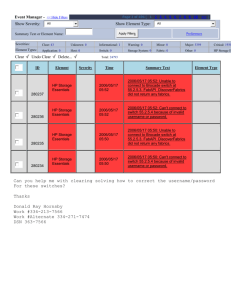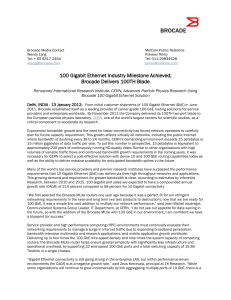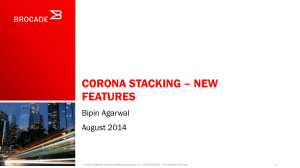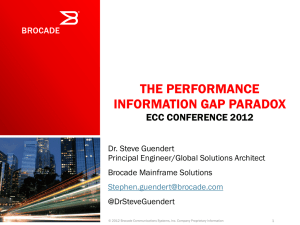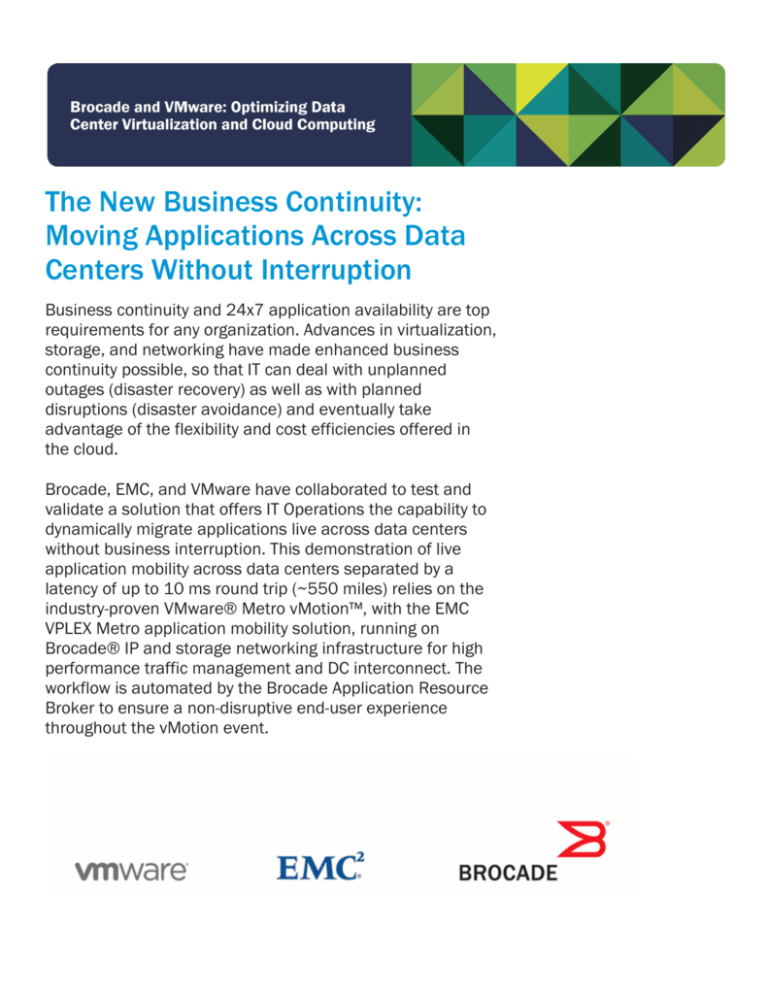
The New Business Continuity:
Moving Applications Across Data
Centers Without Interruption
Business continuity and 24x7 application availability are top
requirements for any organization. Advances in virtualization,
storage, and networking have made enhanced business
continuity possible, so that IT can deal with unplanned
outages (disaster recovery) as well as with planned
disruptions (disaster avoidance) and eventually take
advantage of the flexibility and cost efficiencies offered in
the cloud.
Brocade, EMC, and VMware have collaborated to test and
validate a solution that offers IT Operations the capability to
dynamically migrate applications live across data centers
without business interruption. This demonstration of live
application mobility across data centers separated by a
latency of up to 10 ms round trip (~550 miles) relies on the
industry-proven VMware® Metro vMotion™, with the EMC
VPLEX Metro application mobility solution, running on
Brocade® IP and storage networking infrastructure for high
performance traffic management and DC interconnect. The
workflow is automated by the Brocade Application Resource
Broker to ensure a non-disruptive end-user experience
throughout the vMotion event.
CONTENTS
INTRODUCTION ....................................................................................................................................................................... 3 APPLICATION MOBILITY OVER DISTANCE: USE CASES ............................................................................................................ 3 METRO VMOTION REQUIREMENTS ........................................................................................................................................ 4 BROCADE, EMC, and VMWARE JOINT SOLUTION ................................................................................................................... 5 SOLUTION ARCHITECTURE FOR METRO VMOTION WITH VPLEX AND BROCADE IP AND SAN NETWORKING ....................... 6 JOINT SOLUTION TESTING ....................................................................................................................................................... 8 CONCLUSION ......................................................................................................................................................................... 11 APPENDIX A—SOLUTION COMPONENTS OVERVIEW ........................................................................................................... 12 APPENDIX B—TEST RESULTS ................................................................................................................................................. 21 APPENDIX C—SOLUTION VALIDATION NETWORK TOPOLOGY ............................................................................................. 22 APPENDIX D—EQUIPMENT LIST ............................................................................................................................................ 23 ABOUT VMWARE .................................................................................................................................................................. 24 ABOUT EMC .......................................................................................................................................................................... 24 ABOUT BROCADE .................................................................................................................................................................. 24 Page 2
INTRODUCTION
Virtualization is now recognized as a key technology for improving the efficiency and cost effectiveness
of a company’s information technology infrastructure. As a result, critical business applications are
being moved to virtualized environments, bringing with them requirements for higher availability,
protection of critical business data, and the ability to fail-over and continue supporting business
operations in the case of a local outage or a widespread disaster.
VMware vMotion is a feature of VMware’s ESX servers that allows the live migration of virtual machines
from one ESX server to another with no application downtime. Typically, vMotion has been used within a
data center to keep IT environments up and running, giving unprecedented flexibility and availability to
meet the increasing demands for data. Recent developments, however, have made it possible to
migrate VMs between data centers with no downtime or user disruption. .
Because IT can now perform a secure migration of a live virtualized application and its associated
storage between data centers with no downtime or user disruption, IT managers can realize the benefits
of disaster avoidance and recovery, load balancing between data centers, better leverage of a cloud
infrastructure, optimization of power consumption, and maintaining the right level of performance for
applications.
vMotion over distance, spanning data centers or geographical boundaries, requires a specialized
infrastructure/environment. Three areas are key:
Data synchronization between data centers, allowing servers, regardless of their location, to
have access to that data at all times
The network infrastructure that provides high performance, high reliability, and proper layer 2
extension capabilities to interconnect the data centers
IP traffic management of client network access to the site where the application server resides
This white paper looks at a solution addressing those three key areas through the combination of
VMware Metro vMotion with optimal storage extension capabilities from the EMC VPLEX family, running
over a Brocade network and storage infrastructure. Continuous access to data is provided by the EMC
VPLEX Metro. The Brocade IP and storage networking infrastructure provides a reliable and highperformance end-to-end solution with network adapters; edge, aggregation, and core switching, as well
as high-performance application delivery controllers. This combination provides a flexible infrastructure
resulting in simplification, reduced costs, higher resource utilization and most importantly, data
protection and resiliency.
In the white paper, we detail use cases for application mobility spanning data centers, the components
of this business continuity solution, and the solution architecture that was jointly tested and validated by
VMware, EMC, and Brocade.
The combination of VMware Metro vMotion, from the leader in server virtualization, with VPLEX Metro
Solutions from EMC and the Brocade networking infrastructure, enables the design and implementation
of a robust disaster avoidance and recovery solution for virtualized application environments.
APPLICATION MOBILITY OVER DISTANCE: USE CASES
VMware vMotion uses VMware’s clustered file system, VMFS, to enable access to a virtual machine’s
storage. The underlying storage used by the VMFS datastore is one or more VPLEX Metro Distributed
RAID (DR) volume(s), accessible by all the vSphere hosts. During vMotion, the active memory and
precise execution state of a virtual machine are rapidly transmitted over a high speed network from one
physical server to another and access to the virtual machine’s disk storage is instantly switched to the
new physical host. The virtual machine retains its network identity and connections after the vMotion
operation, ensuring a seamless migration process. The ability to use the powerful feature of Metro
vMotion to migrate VMs over an extended distance creates a new paradigm for business continuity,
enabling newer data center functions such as disaster avoidance, data center load balancing, and data
center resource (power and cooling) optimization.
Page 3
Figure 1: VMware vMotion
Disaster avoidance: vMotion over distance allows IT managers to migrate applications in
preparation for a natural disaster, such as a hurricane, or a planned outage, such as data
center updates for fiber paths, air conditioning, or power. Rather than recovering after the
occurrence of the event, vMotion over distance helps avoid the disaster effects. Disaster
avoidance is preferable to disaster recovery whenever possible. Disaster avoidance augments
disaster recovery and provides IT managers with better control over when and how to migrate
services.
User performance/load balancing between data centers: In typical environments, a large
percentage of data center capacity is set aside for “spikes” during peak demand.
Backup/disaster recovery data centers are often idle. The solution is to relocate virtual server
hotspots to underutilized data centers; this increases utilization of compute, network, and
storage assets. Current assets are utilized as “spike insurance.” Moving workloads “on the fly”
allows the leverage of external cloud resources to handle load during peak demand periods.
Optimization to decrease power costs: Exploit energy price volatility between data center
regions and time-of-use. The dynamic move of VMs to data centers with cheaper energy
provides cost savings. An MIT study on Akamai workload shows that it is possible to achieve
40 percent savings ($4 million/year) arbitraging energy price differentials (Cutting the Electric
Bill for Internet-Scale Systems: http://citeseerx.ist.psu.edu/ ).
Zero downtime maintenance: Eliminating downtime during maintenance is a key advantage
that vMotion over distance enables. Virtual machines can be relocated to a remote data center
during maintenance windows, allowing users to enjoy continuous access to applications in a
fully transparent manner.
DR Drills: Disaster recovery drills can be performed on live applications without impacting the
business. Additionally this would also let businesses completely test the functionality of the DR
site with actual user load.
METRO VMOTION REQUIREMENTS
Successfully performing a vMotion over extended distance requires the following:
An IP network with a minimum bandwidth of 250 Mbps/migration
Maximum latency between the two VMware vSphere servers cannot exceed 10 milliseconds
(ms).
The IP subnet on which the virtual machine resides must be accessible from both the source
and destination vSphere servers. This requirement is very important because a virtual machine
retains its IP address when it moves to the destination vSphere server to help ensure that its
communication with the outside world (for example, with TCP clients) continues smoothly after
the move.
The data storage location, including the boot device used by the virtual machine, must be
active and accessible by both the source and destination vSphere servers at all times.
Page 4
Access from vCenter server and vSphere client to both vSphere servers must be available to
accomplish the migration.
Best practices for vCenter server availability should be followed to achieve business continuity.
Figure 2: Metro vMotion with EMC VPLEX BROCADE, EMC, and VMWARE JOINT SOLUTION
Building the right storage and network infrastructure to enable data and application mobility requires a
data center infrastructure that can provide both optimal storage extension capabilities as well as
advanced network functionality end-to-end. It is imperative that a complete, comprehensive solution
comprising storage, network, and server infrastructure be designed and implemented to facilitate the
movement of applications across data centers. These products from Brocade, EMC, and VMware have
been validated in the joint solution:
VMware vSphere 5 with Enterprise Plus licensing to enable Metro vMotion
EMC VPLEX Metro to ensure the availability of access to the storage in both data centers
Brocade VDX™ switching platforms, built on Brocade VCS technology, to provide a scalable and
resilient Ethernet fabric for VMware server attachment at the network edge in a top of rack
deployment
Brocade MLX and CES platforms for IP network aggregation and core and L2 data center
extension with MPLS based VPLS
Brocade DCX Directors for storage extension, with FCIP and FastWrite technology
Brocade Application Resource Broker (ARB)–working in tandem with the Brocade ADX -- to
provide high availability and seamless client access to the application by combining Global
Server Load Balancing (GSLB) with the automated application mobility capabilities of ARB.
Brocade ADX for application high availability and seamless client access to VMs
Brocade Converged Network Adaptors (CNAs) and Host Bus Adaptors (HBAs) for ESX/ESXi
servers for Ethernet and fiber channel connectivity to the IP and storage networks, respectively
Brocade Network Advisor for unified end-to-end solution management, including IP and
storage networks
Appendix A has detailed descriptions of all the components of this solution.
Page 5
Brocade, EMC, and VMware jointly tested and validated the solution. The following sections provide a
detailed view of the topology and the testing that was performed to ensure the optimal working of the
solution.
SOLUTION ARCHITECTURE FOR METRO VMOTION WITH VPLEX AND BROCADE IP AND SAN NETWORKING
The solution architecture consisted of two data centers interconnected by Brocade infrastructure as
shown in Figure 3:
Figure 3: Solution architecture for Metro vMotion with EMC VPLEX on Brocade
infrastructure.
VMware Metro vMotion for Application Mobility
VMware vSphere servers were running in each data center and facilitated the mobility of virtual
machines using vMotion. VCenter was used to manage the VMware environment, and was augmented
by the Brocade Application Resource Broker (ARB) vCenter plug-in.
EMC VPLEX and Storage Arrays for Active/Active Data Availability
EMC VPLEX GeoSynchrony™ versions 4.2 and 5.0 were used for the solution validation. EMC VMAX and
DMX-4 storage arrays were used as the data stores in the two data centers. The EMC storage arrays and
VPLEX were interconnected through the Brocade DCX backbone director.
Storage Extension with Brocade Storage Director DCX
When architecting for vMotion over distance, one consideration is what type of network to implement for
VPLEX-to -PLEX connectivity between the two data centers. For data centers that are within metro
distances, a customer may choose to run over a DWDM/CDWM solution. The DCX backbone will handle
the flow control between the two locations using Inter Switch Links (ISLs) buffer credits to keep the pipe
full. When the vMotion is initiated, the storage can now be accessed locally by the VM in the other
datacenter.
A second option would be to replicate the data over a fiber channel over IP (FCIP) solution that provides
flexible network choices, encryption, compression, and protocol enhancements to mitigate latency. For
this solution the DCX has the capabilities of inserting an extension blade (FX-24) that can be used to
Page 6
replicate the storage between data centers using an IP infrastructure. The FCIP solution can also be
provided using a standalone device (Brocade 7800) at either or both sites to handle the FCIP replication
between arrays.
Data Center Ethernet Fabric with Brocade VDX
Virtual machines (VMware) in particular are driving the need for a larger layer 2 domain-to-domain
mobility. Brocade’s Ethernet fabric technology enables customers to deploy a larger layer 2
infrastructure, while providing equal cost multi-pathing (ECMP) and load balancing to support the heavy
I/O loads of mobility. Using automatic migration of port profiles (AMPP) associated with the VMs, the
applications residing on the VM are assured adequate network resources and configurations (such as
VLAN profile, QoS and security ACLs) are available and applied throughout the Ethernet fabric when a
VM is moved between vSphere servers.
Data Center Core and Extension with VPLS with Brocade MLX and CES
The VDX-based Ethernet fabrics in each data center are extended with the Brocade MLX and CES. The
MLX and CES products implement a complete standards-based MPLS solution. MPLS enables the
deployment of layer 2 and layer 3 VPNs between data centers. The layer 2 VPNs are implemented
through VPLS for multipoint-to-multipoint or VLL for point-to-point VPNs. The solution is interoperable
with any MPLS network and can also be implemented on any IP network connecting the two data
centers without forcibly requiring MPLS end-to-end. With these capabilities, virtual machines can
seamlessly move between the data centers without the need for any reconfiguration.
In addition to the layer 2 extension between data centers, the MLX and CES provide several advantages
to the vMotion over distance solution: Extremely fast convergence in the case of failures with the fast
reroute (FRR) capability, device high availability and redundancy, high performance, and very low
latency.
Automated Workflow and Global Server Load Balancing with Brocade ADX and the Application
Resource Broker
As an integrated plug-in to VMware vCenter, the Brocade Application Resource Broker in conjunction
with Brocade ADX offers seamless access for clients connecting to VMs that migrate between data
centers..
When a vMotion event happens, whether it is local or remote, an intelligent application traffic manager
is needed to redirect the client’s request to the right location to ensure continued access to the
application. This request should be as transparent to the client as possible. ADX offers this capability by
redirecting client sessions to the right VMware server in a manner that is fully transparent and nondisruptive to the client. The advanced capabilities in the ADX allow the automatic detection of VM
movement through the interaction of ARB with VCenter. ARB is a plug-in that integrates in vCenter and is
able to act on events triggered by the VM movement and initiate actions on the ADX to seamlessly
redirect clients to the new server where the VM has moved.
Page 7
JOINT SOLUTION TESTING
Figure 4 highlights the topology used on the validation of the joint solution.
Figure 4: Tested network topology for Metro vMotion with EMC VPLEX on Brocade infrastructure.
The solution was validated with a suite of real life simulating applications to stress different components
of the solution. The applications used for testing were:
SPECjbb Benchmark – for stressing the vSphere’s capability to move large workloads across
the network and the capability of the migration network to deliver the network performance
needed to perform migration
DVDStore SQL Database Benchmark – a benchmark simulating a complete e-commerce
application that processes the orders of buying DVDs from an online store. The client-server
nature of the benchmark is ideal for stress testing the IP network traffic management between
data centers
SwingBench – an Oracle benchmark with a client-server architecture used to ensure the
network traffic management between data centers
Components Tested
The specific solution components tested were:
EMC VPLEX Metro solution and Storage Area Network (SAN) devices virtualize the backend
storage, which in the test were an EMC VMAX and DMX-4 at the primary and remote site
respectively. The VPLEX, VMAX, and DMX are connected to the respective data center SAN
fabric made of the DCX backbone directors.
Page 8
Brocade IP Network and Wide Area Network (WAN) – for the testing the synchronous data
replication between the VPLEX clusters in the two data centers is performed using FCIP over
the WAN. The SANs are extended using the extension blades (FX8-24) in the DCX directors.
Application server VMs on vSphere 5 accessing the data stores (VMFS) on the VPLEX using
Brocade 825 HBAs. The Brocade 1020 CNAs are used to provide LAN connectivity for the
vSphere server to the Brocade Ethernet fabric, provided at each site with top-of-rack VDX 6720
switches. The Ethernet fabric virtual cluster switch is connected with a vLAG to the Brocade
MLX at each site. Between the Brocade MLXs a VPLS over MPLS tunnel is created and allowing
the layer 2 domains to be extended between the two Ethernet fabrics, facilitating both VM
access and vMotion capability.
The Brocade ADXs integrated with the Brocade ARB vCenter plug-in ensure that clients
automatically are directed directly to the site where the application server resides.
Appendix D provides a detailed list of the equipment used in the tests.
Test results: SPECjbb Testing
SPECjbb emulates a 3-tier system, the most common type of server-side Java application today.
Business logic and object manipulation, the work of the middle tier, predominate; clients are replaced by
user threads, and database storage by Java collections. The benchmark steps through increasing
amounts of work, providing a graphical view of scalability. The benchmark is a CLI oriented benchmark
used to stress the migration network and migration process within the vSphere servers.
Migration Time
300
250
200
150
Migration Time
100
50
0
0
0
2
4
6
8
10
Figure 5: SPECjbb VM migration times Test results: SwingBench Testing
SwingBench is a load generator used to stress test the network IP management between data centers.
The benchmark is primarily used to stress the working of the Application Resource Broker (ARB) and the
Application Delivery Controller (ADX) of IP traffic management between data centers.
Page 9
Figure 6: Metro vMotion of SwingBench VM Test results: DVD Store Application Mobility Testing
This set of tests measured the orders per minute (OPM) for the DVD store application with different
simulated WAN delay values. The VM was configured to move from the primary data center to the
remote data center while clients were accessing the application. Delays of 3 and 5 ms were introduced
and OPM was measured at 19,500 and 18,500, respectively. The 5 ms round trip time (RTT) was
introduced to emulate latency between the two data centers, which is the currently supported value for
VPLEX Metro.
Additional proof of concept tests were performed to go beyond the 5 ms value with an RTT of 7.5 ms
and 10 ms; the results showed 16,500 OPM and 13,869 OPM, respectively, with no application
disruption. The latency of 10 ms approximately translates into 1000 kilometers between the vSphere
servers. With the assumption that the data center LAN network has 500 s latency within the data
center, it is then safe to assume a latency of 9 ms or a distance of 900 kilometers or 562.5 miles
between data centers.
The VM was able to complete the full migration without any traffic disruption. Clients connected to the
application did not see any interruption. The Brocade ADX redirected client sessions to the new VM in
the remote data centers. The ADX, with the global server load balancing and ARB capabilities, ensured
that new clients were able to transparently connect directly to the remote data center.
Page 10
Figure 7: Application performance across 10 ms or 600 Miles distance Test Results: Measurements Performance Data
The Brocade FastWrite feature is designed to overcome the latency effects for write operations, without
compromising data integrity and security. FastWrite allows the entire data sequence of a write operation
to be transported across a link, without the inefficiencies of waiting for the “transfer ready” to travel
back across the high-latency environment. Brocade FastWrite is available with either FC-based or FCIP
extension.
In addition to the tests for application performance and migration time, additional tests were performed
to show the positive effects of the Brocade FastWrite capability available on the DCX backbone
directors. Sequential write operations at different block sizes and different delay values between the two
data centers were performed using IOmeter. Tests results showed that response time and IOPS were
improved more than 2.5 times compared to not using FastWrite. (For more on the FastWrite results, see
Appendix B.)
CONCLUSION
Businesses expect more and more from their compute, storage, and networking infrastructure. They
need to be able to utilize the infrastructure to its best capacity, while giving their users and customers
uninterrupted access to applications. Brocade, EMC, and VMware designed, tested, and validated a
business continuity solution with VMware vMotion and EMC VPLEX running on Brocade networking
infrastructure. The solution allows seamless mobility for applications between data centers, with
continuous access to data provided by EMC VPLEX Metro. The Brocade IP and storage networking
infrastructure offers a reliable and high-performance end-to-end solution with network adapters, edge,
aggregation, and core switching as well as high-performance application delivery controllers.
The Brocade infrastructure offers several benefits for IT Operations when deploying a business
continuity solution with VMware vMotion and EMC VPLEX:
A flexible offering that adapts to IT Operations budgets and network size
An Ethernet fabric-based solution with designed-in capabilities to facilitate vMotion
A standards-based end-to end solution, easy to configure and deploy with Brocade Network
Advisor
Workflow automation at the application layer to ensure undisrupted application access
Performance benefits that enhance application response time and increase users’ productivity
with capabilities unique to Brocade, such as the Brocade DCX FastWrite feature.
A clear TCO advantage
Page 11
APPENDIX A—SOLUTION COMPONENTS OVERVIEW
EMC VPLEX
EMC VPLEX represents the next-generation architecture for data mobility and information access. This
architecture is based on EMC’s 20-plus years of expertise in designing, implementing, and perfecting
enterprise-class intelligent cache and distributed data protection solutions.
VPLEX is a solution for federating EMC and non-EMC storage. VPLEX resides between the servers and
heterogeneous storage assets and has unique characteristics in its architecture:
Scale-out clustering hardware lets you start small and grow big with predictable service levels
Advanced data caching utilizes large-scale SDRAM cache to improve performance and reduce
I/O latency and array contention
Distributed cache coherence provides automatic sharing, balancing, and failover of I/O within
and between VPLEX clusters
A consistent view of one or more LUNs between VPLEX clusters separated either by a few feet
within a data center or across asynchronous RTT distances enables new models of high
availability, workload mobility, and collaboration.
Figure 8: A multi‐cluster deployment of VPLEX
The EMC VPLEX family today consists of:
VPLEX Local for managing data mobility and access within the data center using a single
VPLEX cluster.
VPLEX Metro for mobility and access across two locations separated by inter-site RTT of up to
10 ms1. VPLEX Metro uses two VPLEX clusters and includes the unique capability where a
remote VPLEX Metro cluster can present LUNs without the need for physical storage for those
LUNs at the remote cluster. It also supports synchronous distributed volumes that mirror data
between the two clusters using write-through caching.
VPLEX Geo, which also uses two VPLEX clusters, adds access between two sites over extended
asynchronous distances with RTT latencies up to 50 ms. VPLEX Geo distributed volumes
support AccessAnywhere distributed mirroring using write-back caching.
At the highest level, VPLEX has unique capabilities that customers value.
1
First, VPLEX is distributed, because it can connect multiple sites together over distance,
allowing secure and consistent collaboration across distributed users.
RPQ Process required
Page 12
Next, VPLEX is dynamic, because it is a single interface for multi-vendor storage and it delivers
dynamic data mobility, which is being able to move applications and data in real time, with no
outage required.
And finally, VPLEX is smart, because its unique AccessAnywhere technology can present and
keep the same data consistent within and between sites, even across distance.
VPLEX addresses three distinct customer requirements:
Mobility: The ability to move applications and data across different storage installations—within
the same data center, across a campus, or within a geographical region. And now, with VPLEX
Geo, users can move data across even greater distances.
Availability: The ability to create high-availability storage infrastructure across these same
varied geographies with unmatched resiliency.
Collaboration: The ability to provide efficient real-time data collaboration over distance for such
“big data” applications as video, geographic/oceanographic research, and others.
VMware Metro vMotion
VMware vMotion technology, deployed in production by 70 percent of VMware customers (Source:
VMware 2009 Customer Survey), leverages the complete virtualization of servers, storage, and
networking to move an entire running virtual machine instantaneously from one server to another.
VMware vMotion uses VMware’s cluster file system to control access to a virtual machine’s storage.
During a vMotion, the active memory and precise execution state of a virtual machine is rapidly
transmitted over a high speed network from one physical server to another and access to the virtual
machines disk storage is instantly switched to the new physical host. Since the network is also
virtualized by the VMware host, the virtual machine retains its network identity and connections,
ensuring a seamless migration process.
VMware vSphere 5 has introduced a new feature Metro vMotion® that would extend the capabilities of
the existing vMotion feature. Metro vMotion supports up to 10 ms Round Trip Time (RTT) latency
between vSphere hosts and also reduces the bandwidth requirements to 250 Mbps per migration from
the earlier 622 Mbps for Long Distance vMotion.
VMware vMotion allows you to:
Perform live migrations with zero downtime, undetectable to the user.
Continuously and automatically optimize virtual machines within resource pools.
Perform hardware maintenance without scheduling downtime and disrupting business
operations.
Proactively move virtual machines away from failing or underperforming servers.
Benefit from the reliability and manageability derived from a production-proven product used by
thousands of customers for years. Live migration of virtual machines across IT infrastructure is
surprisingly simple with functionality that lets you:
Perform multiple concurrent migrations to continuously optimize a virtual IT environment.
Identify the optimal placement for a virtual machine in seconds with a migration wizard
providing real-time availability information.
Migrate any virtual machine running any operating system across any type of hardware and
storage supported by vSphere, including Fibre Channel SAN, NAS and iSCSI SAN.
Prioritize live migrations to ensure that mission-critical virtual machines maintain access to the
resources they need.
Schedule migrations to happen at pre-defined times, and without an administrator’s presence.
Maintain an audit trail with a detailed record of migrations.
Page 13
Figure 9: VMware Metro vMotion A Metro vMotion operation can be done between datacenters, say from Datacenter 1 to Datacenter 2
You can vMotion over distance a virtual machine from one datacenter to another to avoid disasters,
migrate workloads to save power, or load balance workloads.
Brocade ADX Series
The Brocade ServerIron ADX Series of high-performance application delivery switches provides a broad
range of application optimization functions to ensure the reliable delivery of critical applications and
infrastructure services. Purpose-built for large-scale, low-latency environments, the Brocade ADX Series
accelerates application performance and improves application availability–all while making the most
efficient use of existing infrastructure. To achieve this, the ADX efficiently distributes application
services by measuring key factors such as server utilization and connection load in real time -- providing
visibility and manageability of application performance, security, and service delivery.
Organizations deploying multiple, geographically disparate data centers can also benefit from the Global
Server Load Balancing (GSLB) capabilities of the ADX. This capability allows the Brocade ADX switches to
distribute client traffic among data center sites based on site availability, site load, and several other
metrics. The Brocade ADX switches determine client-to-server proximity by computing the round-trip
delay between the client and the data center site. To provide the optimal user experience, the leastloaded, closest available sites to the client are selected to deliver application traffic.
In addition to providing proximity based load balancing, the Brocade ADX switches continually monitor
data center sites to detect any changes in servers or services due to varying health and traffic
conditions. Configurable site load thresholds allow organizations to align health-checking parameters
with the server and service capabilities of each site. All of these features work in conjunction with
existing DNS as well as DNS Security Extension (DNSSEC) servers to minimize service disruption and
maximize application uptime.
In short, the Brocade ADX series enables Web applications to run more efficiently and with higher
availability—streamlining operations, increasing business agility, significantly reducing costs, and helping
service providers to support growth.
Brocade Application Resource Broker
The Brocade Application Resource Broker is an infrastructure software component that simplifies the
management of application resources within IT data centers by automating on-demand resource
provisioning. This solution helps ensure optimal application performance by dynamically adding and
removing application resources such as Virtual Machines (VMs). The Brocade Application Resource
Broker–working in tandem with the Brocade ADX Series–provides these capabilities through real-time
monitoring of application resource responsiveness, traffic load information, and capacity information
from the application infrastructure.
Page 14
Brocade Application Resource Broker delivers a range of capabilities to dramatically simplify
management of public and private cloud environments. Specifically the Application Resource Broker:
Simplifies orchestration and management of application service delivery
Dynamically provisions application and network (Brocade® ServerIron® ADX) resources in
response to changes in application demand
Provides flexibility in managing the rules and policies that automate the Virtual Machine (VM)
provisioning process
Leverages the application intelligence of the ServerIron ADX in the decision to provision
additional resources
Increases visibility and control over the entire application infrastructure that ARB is
simultaneously able to provision VMs across multiple tiers that may or may not include loadbalanced traffic flows.
Working in conjunction with the Brocade Application Resource Broker, the Brocade ADX Series provides
greater application visibility and elasticity in virtualized application and cloud environments.
Brocade VDX and VCS Technology
As IT organizations look for better ways to build clouds and virtualized data centers, they are turning to
high-performance networking solutions that increase flexibility through leading-edge technologies.
Brocade® VDX™ 6720 Data Center Switches are specifically designed to improve network utilization,
maximize application availability, increase scalability, and dramatically simplify network architecture in
virtualized data centers. By delivering Brocade VCS™ technology, the Brocade VDX 6720 helps
organizations build data center Ethernet fabrics—revolutionizing the design of layer 2 networks and
providing an intelligent foundation for cloud computing.
Figure 10: Brocade VCS Technology with Brocade VDX platform
Whether organizations want to enhance their classic hierarchical network architectures, deploy flatter
scale-out fabrics for virtualized data centers, or converge networks, the Brocade VDX 6720 delivers the
innovative technology to enhance and simplify their networks.
For classic Ethernet architectures, Brocade VCS technology enables organizations to preserve existing
network designs and cabling, and to gain active-active server connections without employing Spanning
Tree Protocol (STP). For scale-out fabric architectures, Brocade VCS technology allows organizations to
flatten the network design, provide VM mobility without network reconfiguration, and manage the entire
fabric as a single logical chassis.
Page 15
For data centers that can take advantage of a converged LAN/SAN environment, Brocade VCS
technology provides end-to-end Data Center Bridging (DCB) capabilities, enabling traditional IP and
storage traffic to exist on the same network. Organizations can also use Brocade VCS technology to
prioritize fiber channel over Ethernet (FCoE) and iSCSI traffic to make sure it receives sufficient
bandwidth and remains lossless.
Among Brocade VDX product highlights are the following:
Simplifies network architectures and enables cloud computing by delivering virtual cluster
switching technology
Provides ports on demand flexibility with 16-, 24-, 40-, 50-, and 60-port 10 Gigabit Ethernet
(GbE) models built on Brocade sixth-generation fabric switching technology
Maximizes performance through wire-speed ports with 600 nanosecond port-to-port latency
and hardware-based Inter-Switch Link (ISL) trunking
Provides multi-homed active-active server connections for Ethernet networks
Creates scale-out Ethernet fabrics for virtualized data centers
Enables end-to-end convergence of fiber channel over Ethernet (FCoE), iSCSI, and NAS storage
traffic along with IP LAN data traffic
Simplifies management by maintaining network policies as virtual machines move throughout
the data center with automatic migration of port profiles (AMPP)
Helps reduce operational costs and complexity by enabling the entire fabric to be managed as
a single switch
Brocade DCX Product
Brocade DCX Backbone family includes highly robust 8 Gbps network switching platforms that combine
breakthrough performance, scalability, and energy efficiency with long-term investment protection.
Supporting open systems and System z environments, Brocade DCX Backbones are designed to address
the data growth and application demands of evolving enterprise data centers; enable server, SAN, and
data center consolidation; and reduce infrastructure and administrative costs.
Figure 11: Brocade DCX product family
The Brocade DCX family supports 1/2/4/8/10Gbps fiber channel and FICON, FCIP, and IPFC. To
consolidate server connectivity using data center bridging (DCB) and fiber channel over Ethernet (FCoE)
in open systems environments, the Brocade FCOE10-24 blade enables a high-density, end-of-row
chassis configuration. Alternatively, Brocade 8000 top-of-rack switches can be connected over fiber
channel ISLs to DCX Backbones in the network core.
The Brocade DCX supports DWDM, CWDM, and FC-SONET devices; FCIP, data compression, FastWrite,
read/write Tape Pipelining, QoS, BB credit recovery. The FastWrite capability eliminates latency for
synchronous write integrity and < 5ms delay.
Brocade MLX and CES Products
Page 16
The way organizations communicate and conduct business has changed dramatically in the past
decade. Services such as high-definition video streaming, cloud services, and anytime/anywhere
connectivity not only consume an enormous amount of network capacity, but also create a greater
degree of complexity for network operations. As a result, today’s network planners are seeking solutions
that provide the right mix of scalability, performance, operational simplicity, and cost-effectiveness.
The Brocade MLX Series of high-performance routers, which includes existing Brocade MLX routers and
new Brocade MLXe core routers, is designed to meet these requirements and many others. The Brocade
MLXe routers provide several enhancements to the product family, including rear exhaust for all chassis,
timing capabilities for future applications, and higher slot capacity.
Built with a state-of-the-art, sixth-generation, network-processor-based architecture and terabit-scale
switch fabrics, the Brocade MLX Series provides a rich set of high-performance IPv4, IPv6, and
Multiprotocol Label Switching (MPLS) capabilities as well as advanced layer 2 switching capabilities. As
a result, these routers address the diverse needs in environments that include service provider
backbones, metro Ethernet networks, transit/wholesale networks, Internet service providers (ISPs),
content delivery networks (CDNs), Internet exchange points (IXPs), data centers, and distributed
enterprises.
Brocade MLX product highlights include:
Scalable multiservice IP/MPLS carrier Ethernet routers in 4-, 8-, 16-, and 32-slot options
Fully distributed, non-blocking architecture with up to 15.36 Tbps fabric capacity, providing
packet forwarding rates of approximately 5 billion packets per second
1536 1 GbE, 256 10 GbE, and 32 100 GbE wire-speed ports in a single router
Wire-speed IPv4, IPv6, and MPLS forwarding performance with 1 million FIB entries
Advanced layer 2/3 VPN and multicast capabilities to support residential triple-play and
business services
High-availability design with redundant management modules, switch fabrics, power supplies,
and fans; hitless failover; hitless software upgrades; and non-stop routing
Ideal for a wide range of advanced applications in service provider backbones, metropolitan
area networks (MANs), content service providers (CSPs), data centers, and distributed
enterprises.
Figure 12: Brocade MLX and CES Products The NetIron CES 2000 Series is a family of compact 1U, multiservice edge/aggregation switches that
combine powerful capabilities with high performance and availability. The switches provide a broad set
of advanced layer 2, IPv4, IPv6, and MPLS capabilities in the same device. As a result, they support a
diverse set of applications in metro edge, service provider, mobile backhaul, data center, and large
enterprise networks.
Brocade CES Product Highlights include:
Compact 1U IP/MPLS/VRF-enabled switch that is purpose-built for advanced carrier Ethernet
and large data center applications
Page 17
Wire-speed, non-blocking performance in all configurations
Available in 24-port and 48-port configurations in both hybrid fiber (HF) and RJ45 versions to
suit versatile access/aggregation media
Powered by the field-proven Brocade Multi-Service IronWare OS that also runs on NetIron
XMR/MLX Series routers
Comprehensive IPv4 and IPv6 routing
Virtual Routing in non-MPLS environments via Multi-VRF
The MLX and CES platforms offer great flexibility for any data center deployment that takes into account
budget, network size and scale, and connectivity options required. The Brocade CES is ideal for smaller
deployments without compromising the VPLS/VLL feature set, while the MLX offers a range of chassis
size options to scale to very large size networks. The Brocade MLX and CES provide gigabit Ethernet, 10
gigabit Ethernet and 100 gigabit Ethernet all at line rate for industry leading performance allowing the
fast and reliable migration of virtual machines and data between data centers.
Brocade HBAs and CNAs
Brocade connectivity solutions reliably connect servers to storage and converged networks. Brocade 4
and 8 Gbps Host Bus Adapters (HBAs) connect tower, rack, and blade servers, while Brocade 10 Gbps
Converged Network Adapters (CNAs) provide industry-leading performance and connectivity for
virtualized infrastructures.
Figure 13: Brocade HBAs and CNAs
The Brocade® 415 and 425 4 Gbps fiber channel Host Bus Adapters (HBAs) and the Brocade 815 and
825 8 Gbps fiber channel HBAs are a new class of server connectivity products with unmatched
hardware capabilities and unique software features. This new class of HBA is designed to help IT
organizations deploy and manage end-to-end storage area network (SAN) services across nextgeneration data centers.
While legacy HBA providers focus on simple connectivity, the Brocade 4 Gbps and 8 Gbps HBAs leverage
five generations of application-specific integrated circuit (ASIC) design. The current ASIC is an evolution
of the industry-leading Brocade fiber channel switching ASIC. It leverages the same technology and
features that make Brocade the market leader in storage networking, including frame-based trunking for
additional performance and availability, and virtual channels for quality of service (QoS) and isolation.
This enables organizations to extend essential Brocade advanced fabric services into the server.
Brocade HBA highlights include:
Centralizes management across the data center by leveraging Brocade Data Center Fabric
Manager (DCFM)
Provides fabric-based boot logical unit number (LUN) discovery for simplified storage area
network (SAN) boot configuration for diskless server deployments
Maximizes bus throughput with a fiber channel to PCIe Gen2 (x8) bus interface with intelligent
lane negotiation
Delivers unprecedented performance with I/O transfer rates of up to 500,000 IOPS per port
and 1,000,000 IOPS per dual-port adapter
Page 18
Provides throughput of up to 1600 MB/sec per port full duplex (800 MB/sec per port on 4
Gbps models)
Supports N_Port ID Virtualization (NPIV) with up to 255 virtual ports
Extends advanced fabric services such as Quality of Service (QoS) to the application level
The Brocade 1010 (single port) and Brocade 1020 (dual port) CNAs consolidate connectivity for
networking and fiber channel-based storage I/O consolidation using FCoE and DCB. By offering a single
adapter to replace the dedicated fiber channel HBAs and Ethernet NICs in a data center server, the
Brocade 1010/1020 CNAs reduce both capital and operational expenses—while simplifying
management through Brocade Network Advisor.
The Brocade 1010 and 1020 CNAs provide the industry’s highest levels of IOPS per port: up to 500,000.
In addition to that, these CNAs provide the industry’s highest sustained FCoE throughput performance,
making them ideal for highly demanding storage and transaction-intensive applications. In addition, they
draw low amounts of energy, helping to keep servers running efficiently.
Brocade CNAs support open industry standards such as T11 FCoE, FIP, and IEEE data center bridging
(DCB) capabilities, including priority-based flow control (PFC 802.1Qbb) and enhanced transmission
selection (ETS 802.1Qaz). As a result, they are designed to provide a smooth transition of DCB/FCoE
into existing data center infrastructures.
Brocade CNA highlights include:
High-performance line-rate 10 Gbps Ethernet for enterprise-class, reliable LAN connectivity
Data center B=bridging (DCB) support for low-latency, lossless, and deterministic 10 Gbps
Ethernet connectivity and storage over Ethernet applications (FCoE/iSCSI)
Advanced Ethernet performance, including IPv4 and IPv6 checksum offload, receive side
scaling (RSS), header data split (HDS), jumbo frame support, and TCP segmentation offload
(TSO)
Scalable connectivity features— including virtual switching offloads— across a secure,
multiprotocol, lossless environment
Unified fiber channel, FCoE, and Ethernet driver stacks that enable a single driver for both
Brocade CNAs and fiber channel HBAs
An integral part of the Brocade DCB/FCoE solution, which includes the Brocade 8000 switch,
the Brocade FCOE10-24 blade for the Brocade DCX Backbone, and Brocade Data Center
Fabric Manager (DCFM)
Brocade Network Advisor
Managing service level agreements (SLAs) in today’s dynamic network environment requires seamless
coordination across a wide range of elements. Often, organizations end up working with numerous
network management tools in order to provide uninterrupted services for virtual, physical, and cloud
data center infrastructures. Server virtualization results in the increased sharing of storage resources
via SANs.
Any connectivity degradation between VMware vSphere/vSpherei servers and their shared storage
resources can have an adverse impact on one or more VMs. This poses a new management challenge,
that is, to correlate the impact on storage networking resources to VMs. Often, this is a non-trivial
operation and customers spend hours or days trying to isolate whether performance issues were due to
server, network, storage, or application issues, or a combination of them. Adding further complexity to
this equation, VM mobility calls for a management solution that not only monitors and relates health of
the SAN to IT administrators but also tracks the dynamic mobility of these VMs and the persistence of
the networking policies associated with them.
Meeting the challenges of a complex, dynamic, and virtualized data center environment requires an
integrated management solution that provides both end-to-end network visibility and a scalable,
standards-based architecture that seamlessly integrates with existing management platforms. As a
trusted data center infrastructure partner, Brocade brings experience to organizations relying on
VMware vCenter for the management of their systems infrastructure. With Brocade Network Advisor,
Brocade delivers a unified network management solution across data, storage, and converged networks,
as well as seamless integration with VMware vCenter.
Brocade Network Advisor is the industry’s first and only unified network management solution for data,
storage, application, and converged networks. It supports fiber channel (FC) SANs, fiber channel over
Ethernet (FCoE), IP switching and routing, wireless, and Multiprotocol Label Switching (MPLS) networks—
providing both end-to-end network visibility and comprehensive lifecycle management capabilities
across these different network types in a single application via a seamless and unified end-user
Page 19
experience. Brocade Network Advisor provides comprehensive management of MPLS services through
the MPLS Manager, supporting MPLS virtual private LAN services (VPLS), label switched path (LSP), local
VPLS, MPLS virtual leased line (VLL), and local VLL services with an intuitive interface. The point and
click capabilities tremendously simplify the deployment of MPLS solutions.
Figure 14: Brocade Network Advisor Brocade Network Advisor highlights include:
Bridges operational gaps across VM, server, network, and storage administrators with end-toend network visibility
Enables visibility into the health and performance of SAN infrastructure as it relates to VMs
Displays VM SAN connectivity in the vSphere client
Empowers VM administrators with network bottleneck identification for faster problem
resolution
Page 20
APPENDIX B—TEST RESULTS
Response Time with and without Fast Write
In these tests, sequential write operations only, with no vMotion were performed using IOmeter. block
sizes of 1MB and 4K. The delay between the two data centers was at 10ms round trip time. In the first
test, FastWrite was not enabled on the DC; then measurements were taken with FastWrite enabled. The
below graph shows the test results with an improvement of more than 2.5 times for response time.
Figure 15: Response time with and without FastWrite IOPS with and without FastWrite
The following graph compares IOPS with and without FastWrite enabled. It shows an improvement of
more than 2.6 times with FastWrite.
Figure 16: IOPS Measurements with and without FastWrite Page 21
APPENDIX C—SOLUTION VALIDATION NETWORK TOPOLOGY
Figure 17 shows the topology of the network used for the solution validation.
Figure 17: Overall Solution Validation Topology Page 22
APPENDIX D—EQUIPMENT LIST
Server
H/W Spec
Windows
Intel Xeon X5670, 2.93GHz
2 sockets, 6 cores, 32GB RAM
VMware
Intel Xeon X5670, 2.93GHz
2 sockets, 6 cores, 32GB RAM
(VM)
Intel Xeon X5670, 2.93GHz
4 CPU, 8GB RAM
Windows
Intel Xeon X5670, 2.93GHz
2 sockets, 6 cores, 32GB RAM
VMware
Intel Xeon X5670, 2.93GHz
2 sockets, 6 cores, 32GB RAM
VMware
Intel Xeon X5670, 2.93GHz
2 sockets, 6 cores, 32GB RAM
VMware
Intel Xeon X5670, 2.93GHz
2 sockets, 6 cores, 32GB RAM
IP and SAN extension
Switches
Brocade DCX Director, Brocade MLX-4,
Brocade VDX-6720, Brocade ADX1000
and Brocade ARB
EMC VPLEX and Storage
Arrays
VPLEX-Metro, VMAX, DMX4
Page 23
ABOUT VMWARE
VMware, the global leader in virtualization and cloud infrastructure, delivers customer-proven solutions
that significantly reduce IT complexity and enable more flexible, agile service delivery. Leveraging
VMware vSphere™, the most widely deployed foundation for cloud computing, VMware accelerates the
transition to a cloud computing approach while preserving existing investments and improving security
and control. With VMware vCloud™ solutions and services, VMware enables private, public and hybrid
cloud deployment models that ensure application mobility and portability.
With more than 190,000 customers and 25,000 partners, VMware helps organizations of all sizes lower
costs, preserve freedom of choice and energize business through IT while saving energy—financial,
human and the Earth’s.
For information visit www.vmware.com.
ABOUT EMC
EMC Corporation is a global leader in enabling businesses and service providers to transform their
operations and deliver IT as a service. Fundamental to this transformation is cloud computing. Through
innovative products and services, EMC accelerates the journey to cloud computing, helping IT
departments to store, manage, protect and analyze their most valuable asset — information — in a more
agile, trusted and cost-efficient way. Additional information about EMC can be found at www.EMC.com.
ABOUT BROCADE
Brocade networking solutions help the world’s leading organizations transition smoothly to a virtualized
world where applications and information reside anywhere. This approach is based on the Brocade
One™ unified network strategy, which enables a wide range of consolidation, convergence,
virtualization, and cloud computing initiatives.
Offering an industry-leading family of Ethernet, storage, and converged networking solutions, Brocade
helps organizations achieve their most critical business objectives through unmatched simplicity, nonstop networking, application optimization, and investment protection. To ensure a complete solution,
Brocade partners with world-class IT companies and provides a full range of education, support, and
professional services offerings.
For more information about Brocade products, services, and solutions, visit www.brocade.com.
Copyright © 2011 VMware, Inc. All rights reserved.
Protected by one or more U.S. Patent Nos. 6,397,242, 6,496,847, 6,704,925, 6,711,672, 6,725,289, 6,735,601, 6,785,886, 6,789,156, 6,795,966,6,880,022, 6,944,699,
6,961,806, 6,961,941, 7,069,413, 7,082,598, 7,089,377, 7,111,086, 7,111,145, 7,117,481, 7,149, 843, 7,155,558, 7,222,221, 7,260,815, 7,260,820, 7,269,683,
7,275,136,7,277,998,7,277,999, 7,278,030, 7,281,102, 7,290,253, 7,356,679 and patents pending.
© 2011 Brocade Communications Systems, Inc. All Rights Reserved. MM/YY Part Number
Brocade, the B-wing symbol, BigIron, DCFM, DCX, Fabric OS, FastIron, IronView, NetIron, SAN Health, ServerIron, TurboIron, and
Wingspan are registered trademarks, and Brocade Assurance, Brocade NET Health, Brocade One, Extraordinary Networks,
MyBrocade, VCS, and VDX are trademarks of Brocade Communications Systems, Inc., in the United States and/or in other countries.
Other brands, products, or service names mentioned are or may be trademarks or service marks of their respective owners.
Page 24

